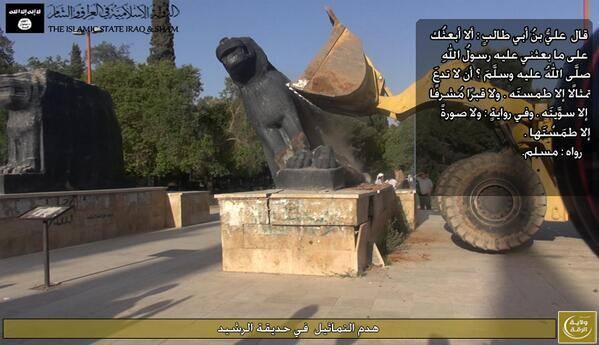Fighters with the Islamic State of Iraq and the Levant, a radical militia that controls a large swath of eastern Syria, confiscated and destroyed illegally excavated antiquities from an ancient Mesopotamian site.
In an act of cultural genocide strikingly similar to the Taliban’s demolition of the
Buddhas of Bamiyan in 2001, the ISIL fighters appear – in pictures recently uploaded by a group working to protect Syria’s rich historical heritage — to smash a 3,000-year-old Neo-Assyrian statue illegally removed from a nearby archaeological site. Another image shows a man placing his foot — an act of disrespect in Arab culture — on the face of the Assyrian statue before its destruction.
Last month, the Syrian antiquities authority said in a statement that it had received notice that artifacts that “appear to be the result of an unauthorized digging” had been plundered from Tell Ajaja, the ruins of the Assyrian provincial capital Shadikanni on the Khabur River, a tributary of the Euphrates.
The pictures, taken in Syria’s far eastern Hasakeh Province, were also said to be of artifacts removed from Tell Ajaja. The site lies approximately 30 kilometers (18 miles) south of the modern provincial capital of Hasakeh and 50 kilometers (30 miles) from the Iraqi border.
It was not immediately clear from the photographs whether the statue that was smashed was genuine. A Tel Aviv Assyriologist who preferred anonymity said that, based on the photos, the statue appeared to be authentic, “although it could be a copy placed outside the museum [in Hasakeh],” he added with due caution.

Members of the Islamic State of Iraq and the Levant stand in front of an Assyrian statue before destroying it (photo courtesy of APSA/Abou Mouseb)

A member of the Islamic State of Iraq and the Levant desecrates an Assyrian statue by putting his foot on its face before it’s smashed (photo courtesy of APSA/Abou Mouseb)

Members of the Islamic State of Iraq and the Levant smash an Assyrian statue (photo courtesy of APSA/Abou Mouseb)
Gaston Maspero, the 19th century French archaeologist, wrote that in the ninth century BCE the palaces of Shadikanni “
were decorated with winged bulls, lions, stelae, and bas reliefs carved in marble brought from the hills of Singar.” Similar artifacts appear to be among those recently plundered.
The looting and destruction of antiquities from Tell Ajaja is part of a terrible tragedy that has befallen Syria’s ancient heritage as the result of the three-year-old civil war ravaging the country. The
New York Timesrecently reported that illegal excavations have accelerated and that the country’s six UNESCO World Heritage sites are now listed as endangered. But Syria, which lies in the Fertile Crescent and houses remains from over 5,000 years of human civilization, is riddled with lesser-known archaeological sites — some of which haven’t been excavated because they were,
until recently, entirely unknown.
The destruction of Assyrian antiquities was not the first assault against Syrian archaeological treasures committed by ISIL. In January 2014, the radical Islamist group blew up and destroyed a sixth-century Byzantine mosaic near the city of Raqqa,
the Independent reported. The pristine Roman-style mosaic had only been discovered in 2007. Syria analyst Aymenn al-Tamimi, one of those who tweeted the images of ISIL smashing the idols in Hasakeh, also shared a photo of the Islamists taking a bulldozer to a statue outside a Raqqa museum. It’s not certain whether or not the lion statue was authentic.

#Syria: ISIS destroying ancient statue in al-Rashid garden,
#Raqqa (few days old, but worth noting)
“You don’t need an expert to tell you that it is terrible, because every artifact contributes to our understanding of the past, the more so when it bears an inscription,” Jack Sasson, professor of classics and Jewish studies at Vanderbilt University, told The Times of Israel.
ISIL, also known as ISIS or by its Arabic initials Daash, has taken control of a large portion of Syria, from the Turkish and Iraqi borders in the east to as far west as the city of Al Bab in Aleppo province.

A map of the Syrian civil war as of May 2014, with ISIL-controlled areas in dark brown. (photo credit: CC BY-SA Wikimedia Commons)
“ISIS no longer exists in small cells that can be neutralized by missiles or small groups of commandos. It is now a real, if nascent and unrecognized, state actor—more akin in organization and power to the Taliban of the late 1990s than al-Qaeda,” security analysts Doug Ollivant and Brian Fishman wrote Wednesday in the online foreign policy magazine
War on the Rocks.
ISIS’s increasingly powerful hold over the eastern half of Syria and the western provinces of Iraq may prove fatal for the region’s already threatened archaeological remains.











No hay comentarios:
Publicar un comentario